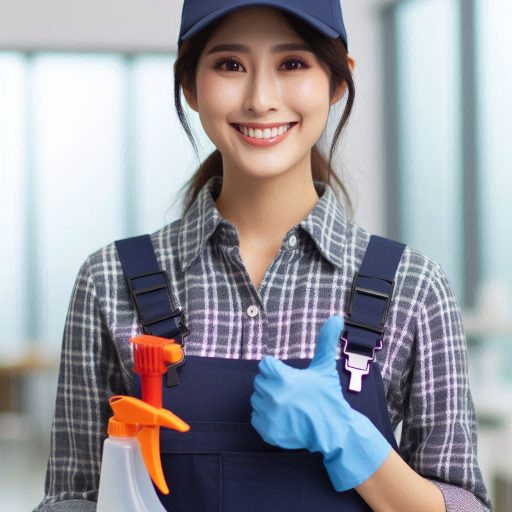Introduction
Modern cleaning services have transformed significantly in recent years.
These services now include residential, commercial, and specialized cleaning options.
Companies focus on meeting diverse client needs while maintaining high standards of cleanliness.
Technology plays a vital role in this evolution.
Technology enhances the efficiency of cleaning operations.
Automated tools like robotic vacuums and floor scrubbers reduce manual labor and save time.
These devices operate quickly and effectively, allowing cleaning staff to focus on more complex tasks.
Additionally, smart sensors can detect dirt and debris, ensuring thorough cleaning.
Software solutions also streamline scheduling and communication.
Cleaning companies can use management software to assign tasks, track progress, and manage staff.
This technology improves coordination and reduces scheduling conflicts, ensuring timely service delivery.
Clients benefit from clear communication and real-time updates about their cleaning services.
Moreover, technology improves the effectiveness of cleaning processes.
Advanced cleaning products and equipment, such as UV-C sterilizers, kill harmful bacteria and viruses.
These innovations create healthier environments for clients, particularly in sensitive areas like healthcare facilities and schools.
Technology also enables the use of eco-friendly cleaning solutions, addressing sustainability concerns.
Furthermore, data analytics can optimize cleaning routes and frequencies.
By analyzing client preferences and cleaning history, companies can provide tailored services.
This approach maximizes client satisfaction and reduces operational costs.
In summary, technology has become essential in modern cleaning services.
Transform Your Career Today
Unlock a personalized career strategy that drives real results. Get tailored advice and a roadmap designed just for you.
Start NowIt enhances efficiency, effectiveness, and customer satisfaction.
As the industry continues to evolve, embracing technological advancements will remain crucial for success.
Evolution of technology in cleaning services
Historical overview of cleaning methods
Cleaning methods have undergone significant changes over the years.
In ancient times, people used simple tools like brooms and cloths.
They relied on manual labor to keep their surroundings clean.
The industrial revolution marked a turning point in cleaning practices.
Factories introduced new materials, increasing the need for efficient cleaning solutions.
In the early 20th century, vacuum cleaners emerged as a revolutionary tool.
These devices replaced manual sweeping and made cleaning more efficient.
The introduction of electric power transformed the cleaning industry.
It paved the way for advanced tools that enhanced productivity and effectiveness.
In recent years, technology has continued to evolve rapidly in cleaning services.
Robotic vacuum cleaners have gained popularity for their convenience and efficiency.
These devices can autonomously navigate spaces, saving time and effort.
Additionally, advancements in cleaning solutions have led to eco-friendly products.
These are safer for both users and the environment.
Introduction of advanced cleaning tools and equipment
Moreover, the introduction of steam cleaning technology has changed deep cleaning.
Steam cleaners effectively sanitize surfaces without harmful chemicals.
This method appeals to health-conscious consumers and environmentally aware clients.
Advanced equipment, such as pressure washers, has also revolutionized outdoor cleaning.
These machines tackle tough stains and grime on various surfaces.
They offer a fast and efficient way to maintain outdoor areas.
Overall, the evolution of technology in cleaning services has enhanced efficiency and effectiveness.
Today’s cleaning professionals benefit from a wide range of tools and solutions.
These innovations not only improve cleaning outcomes but also promote sustainability.
As technology continues to advance, cleaning services will keep evolving, meeting the demands of modern consumers.
Read: Common Challenges Faced by Janitors and Solutions
Role of Robotics in Cleaning Services
Robotic cleaning technology has revolutionized the way cleaning services are delivered.
With automated robots being used for various tasks such as floor cleaning, vacuuming, and disinfecting, the efficiency and effectiveness of cleaning services have significantly improved.
Automated Robots for Floor Cleaning
Automated robots are equipped with advanced sensors and mapping technology to navigate through spaces and clean floors efficiently.
These robots can reach tight spaces and corners that are difficult to clean manually, ensuring a thorough cleaning process.
Automated Robots for Vacuuming
Robotic vacuum cleaners have become increasingly popular for their ability to clean floors without human intervention.
These robots can be programmed to clean at specific times, allowing cleaning services to be delivered even when no one is present.
Automated Robots for Disinfecting
Robotic disinfection systems use UV-C light or other disinfecting methods to kill bacteria and viruses on surfaces.
These robots can be used in hospitals, offices, and other high-traffic areas to maintain a clean and sanitary environment.
Advantages of Robotics in Cleaning Services
- Time-saving: Robots can clean faster and more efficiently than humans, saving time and labor costs.
- Precision: Robots are programmed to follow specific cleaning patterns, ensuring a thorough and consistent cleaning process.
- Consistency: Robots perform cleaning tasks with the same level of precision every time, eliminating human error.
- Safety: Robots can be used in hazardous environments or situations where human safety may be at risk.
In essence, robotics play a crucial role in modern cleaning services by enhancing efficiency, precision, and safety.
With advancements in robotic technology, cleaning services can be delivered with higher quality and consistency, benefitting both service providers and customers alike.
Read: Pharmacy Technician Certification Exam: What to Expect

Impact of smart technology in cleaning services
Integration of smart sensors for monitoring cleanliness levels
Smart technology significantly transforms modern cleaning services, enhancing efficiency and effectiveness.
By integrating smart sensors, businesses can monitor cleanliness levels in real time.
These sensors detect dirt, dust, and allergens, allowing for targeted cleaning where needed.
Consequently, service providers can maintain higher cleanliness standards, improving customer satisfaction.
Smart scheduling and tracking systems streamline operations and optimize workforce management.
These systems allow managers to assign tasks based on real-time data and employee availability.
They provide insights into cleaning performance, helping managers identify areas for improvement.
This data-driven approach ensures that cleaning tasks are completed efficiently and on time.
Implementation of smart scheduling and tracking systems
Moreover, smart technology reduces labor costs by automating routine tasks.
For example, robotic vacuum cleaners can perform floor cleaning while employees focus on more complex tasks.
This automation increases productivity and minimizes human error, resulting in a more thorough clean.
Integration of smart technology also enhances communication between clients and cleaning service providers.
Clients can receive real-time updates on cleaning schedules, service completion, and feedback.
This transparency builds trust and fosters long-term relationships.
Additionally, using smart technology in cleaning services supports sustainability.
Many smart devices are energy-efficient, reducing overall resource consumption.
Monitoring systems can identify areas where cleaning practices can be adjusted for lower environmental impact.
All in all, the impact of smart technology on cleaning services is profound.
By integrating smart sensors and implementing smart scheduling systems, cleaning services improve efficiency and effectiveness.
These innovations lead to higher customer satisfaction, reduced costs, and a cleaner, more sustainable environment.
Embracing smart technology is essential for cleaning companies aiming to thrive in a competitive landscape.
Read: Career Growth Opportunities for Janitors
Utilization of green cleaning technology
Introduction of eco-friendly cleaning products and methods
In recent years, there has been a growing trend towards using eco-friendly cleaning products and methods in modern cleaning services.
This shift is driven by a desire to reduce the environmental impact of cleaning practices while still maintaining high standards of cleanliness.
Benefits of green cleaning in reducing environmental impact
Reduced exposure to harmful chemicals
Traditional cleaning products often contain harsh chemicals that can be harmful to both human health and the environment.
Green cleaning products are made from natural ingredients and are gentler on the planet.
Improved air quality
Many traditional cleaning products release volatile organic compounds (VOCs) into the air, which can contribute to indoor air pollution.
Green cleaning products are formulated to minimize VOC emissions, leading to better indoor air quality.
Lower carbon footprint
Green cleaning methods, such as using microfiber cloths and mops, require less water and energy compared to traditional cleaning methods.
This results in a reduced carbon footprint and less strain on natural resources.
Biodegradable formulations
Green cleaning products are designed to break down easily in the environment, reducing their impact on landfills and waterways.
This helps to preserve ecosystems and wildlife habitats.
Healthier workplace environment
By using green cleaning products, cleaning services can create a healthier workplace environment for employees and customers.
This can lead to improved productivity and morale among staff.
Compliance with regulations
As governments around the world introduce stricter regulations on the use of chemicals in cleaning products, businesses that adopt green cleaning practices are better positioned to comply with these laws and avoid potential fines or penalties.
Basically, the utilization of green cleaning technology in modern cleaning services offers a range of benefits, including a reduced environmental impact, improved air quality, and a healthier workplace environment.
By making the switch to eco-friendly cleaning products and methods, cleaning services can play a significant role in protecting the planet for future generations.
Read: Pharmacy Technician: Role and Responsibilities Explained
Explore Further: The Impact of Locksmiths on Community Safety
Find Out More: Receptionist Job Market Trends in the US
Training and education in technology for cleaning professionals
Cleaning professionals play a crucial role in ensuring that spaces are kept clean and hygienic.
In today’s technology-driven world, it is essential for cleaners to be educated and trained in using technology to enhance their cleaning services.
Importance of educating cleaners on using technology
- Efficiency: With the use of technology, cleaners can work more efficiently and cover a larger area in less time.
- Quality: Technology can help maintain a higher standard of cleanliness and hygiene, ensuring customer satisfaction.
- Safety: Training in using technology can help reduce the risk of accidents and injuries while cleaning.
- Sustainability: Technology can help cleaners reduce their environmental impact by using eco-friendly cleaning solutions.
Training programs for learning new cleaning technologies
- Online courses: Many platforms offer online courses specifically designed for cleaning professionals to learn about new technologies.
- Workshops: Hands-on workshops can provide practical training on using various cleaning equipment and tools.
- Certification programs: Cleaners can enroll in certification programs to learn about the latest cleaning technologies and best practices.
- On-the-job training: Employers can provide on-the-job training to ensure that cleaners are proficient in using technology in their daily tasks.
Investing in the training and education of cleaning professionals in technology can lead to improved efficiency, quality of service, and customer satisfaction.
By staying up-to-date with the latest cleaning technologies, cleaners can enhance their skills and deliver exceptional cleaning services in today’s modern world.
Challenges of adopting technology in cleaning services
Implementing technology in cleaning services can bring numerous benefits, such as increased efficiency and effectiveness.
However, there are also challenges that come with adopting new technology in this industry.
Let’s explore some of the common challenges faced by cleaning service providers when trying to integrate technology into their operations.
The initial cost of technology implementation
One of the primary challenges faced by cleaning service providers when adopting technology is the initial cost of implementation.
Purchasing and installing new cleaning equipment, software, or tools can require a significant upfront investment, which may be prohibitive for smaller companies with limited budgets.
Additionally, training staff to use the new technology effectively can also incur additional costs.
This financial barrier can deter some cleaning service providers from embracing technology, even though the long-term benefits may outweigh the initial expense.
Resistance from traditional cleaning practices
Another challenge in adopting technology in cleaning services is the resistance from employees who are accustomed to traditional cleaning methods.
Some staff members may be hesitant to learn how to use new technology, fearing that it may replace their jobs or require them to acquire new skills.
It is essential for cleaning service providers to address this resistance by providing adequate training and support to help employees transition to using technology seamlessly.
Clear communication about the benefits of adopting technology and how it can improve job performance can also help alleviate employees’ concerns.
Overall, overcoming the challenges of adopting technology in cleaning services requires proactive planning, investment, and effective change management strategies.
By addressing the initial cost barriers and resistance from traditional practices, cleaning service providers can successfully integrate technology into their operations and reap the benefits of improved efficiency and customer satisfaction.
Conclusion
Technology has revolutionized modern cleaning services by streamlining processes and improving efficiency.
With the use of robotic vacuums, smart sensors, and automated cleaning systems, tasks are completed faster and more effectively.
The future possibilities for further advancements in cleaning technology are vast.
We can expect to see even more sophisticated AI-driven systems that can learn and adapt to different environments, as well as eco-friendly solutions that reduce the impact on the environment.
Technology continues to play a crucial role in shaping the landscape of modern cleaning services, and as advancements continue to be made, we can look forward to more innovative solutions that will further enhance the industry.




